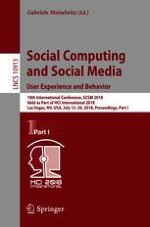The two volumes set LNCS 10913-10914 of SCSM 2018 constitutes the proceedings of the 10th International Conference on Social Computing and Social Media, SCSM 2018, held as part of the International Conference on Human-Computer Interaction, HCII 2018, held in Las Vegas, NV, USA, in July 2018. The total of 1171 papers and 160 posters presented at the 14 colocated HCII 2018 conferences.
The papers were carefully reviewed and selected from 4346 submissions. These papers which are organized in the following topical sections: social media user experience, individual and social behavior in Social Media, privavcy and ethical issues in Social Media, motivation and gamification in Social Media, social network analysis, and agents, models and algorithms in Social Media.
